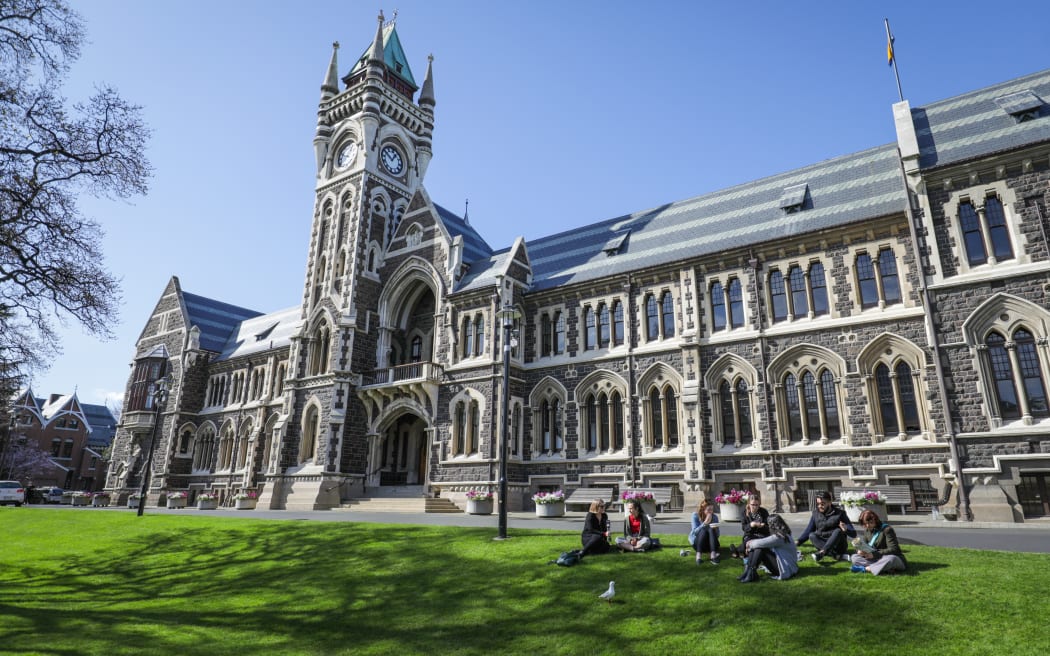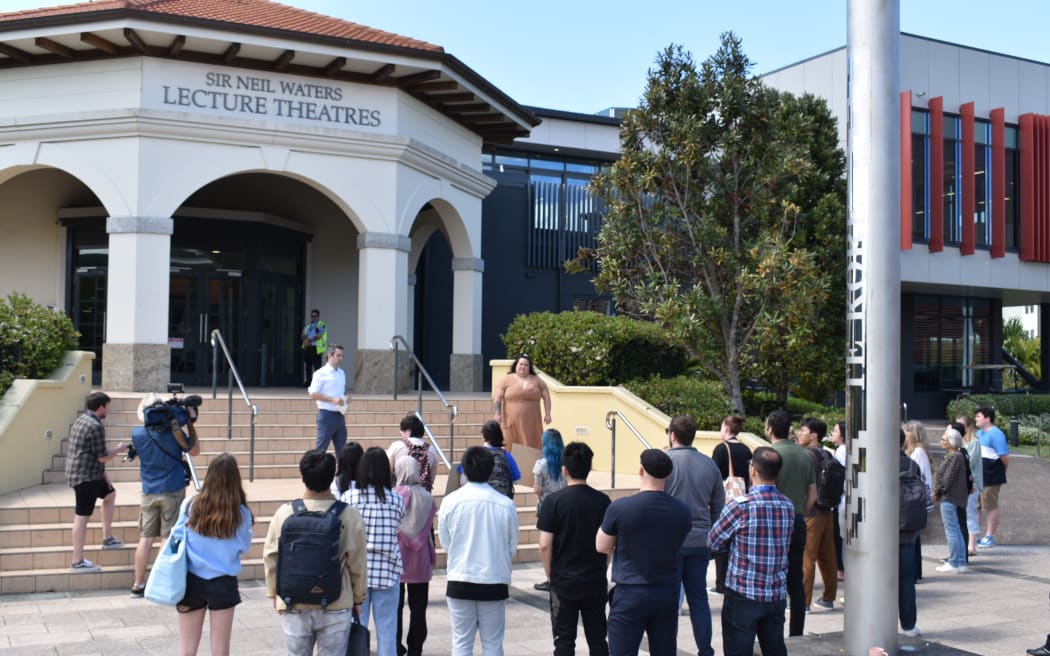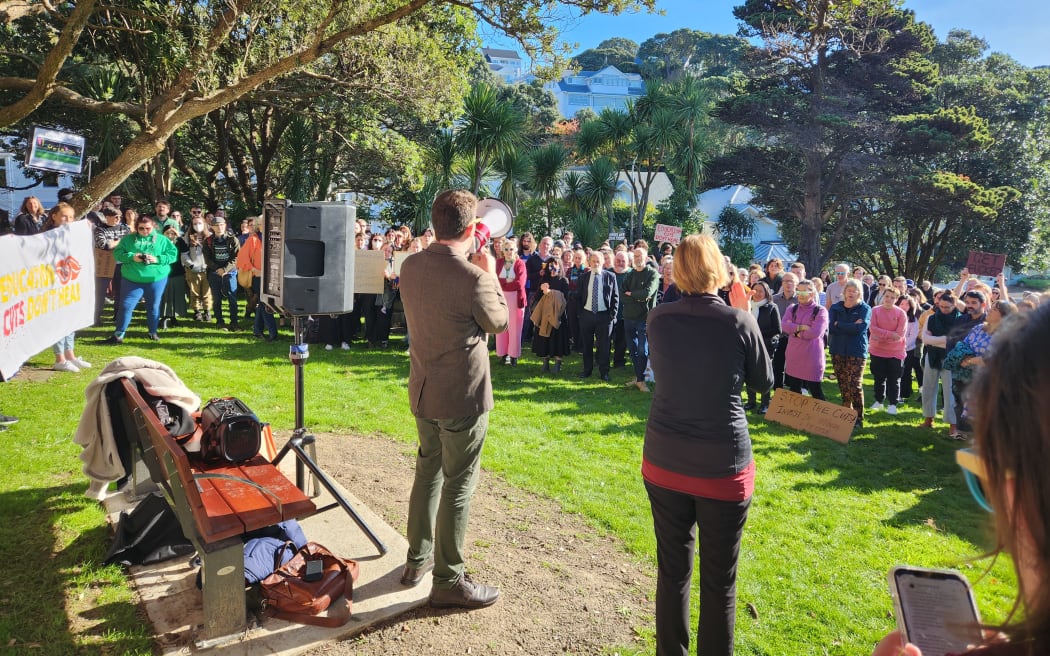
University of Otago. Photo: RNZ / Nate McKinnon
By the end of this year, close to 600 jobs are likely to have been cut from three of the nation's eight universities.
The losses at Massey, Victoria and Otago involve a mix of voluntary and forced redundancies and will eliminate some subjects from some universities altogether.
The plans flagged earlier this year provoked staff and student protests, and prompted the government to stump up $128 million in extra funding for 2024 and 2025 to help universities make ends meet.
But the extra money, provided as a 4 percent increase to subsidies for students enrolled in degree and postgraduate courses on top of a 5 percent increase from this year's Budget, was not enough to prevent the cuts.
After a series of bad years for enrolments, the three universities said they still needed to trim expenses in order to return to financial surplus.
Other universities also experienced falling domestic enrolments last year and this year, but the drops appeared to be more acute at Victoria, Massey and Otago and were not counterbalanced by rising foreign enrolments.
Tertiary Education Commission figures drawn from university annual reports showed Massey, Victoria and Otago had some common features - last year they had more staff relative to students than before the pandemic began and those staff were costing their institutions more at the same time as income was falling.
Staff accounted for 56 percent of expenditure at Massey, Otago and Victoria in 2022, slightly more than at Auckland, Canterbury and Waikato, where the figures ranged from 51-53 percent.
Income per full-time equivalent staff member was about $20,000 lower at Victoria and Otago last year than in 2019, while Massey's figure of $166,800 per FTE was slightly better than in 2019 but remained the lowest in the sector.
Other universities shared some of the above characteristics, but not all.
One industry observer told RNZ it appeared universities had reached a point that polytechnics came to years ago - where cross-subsidisation of loss-making courses with profits from other courses no longer worked.
University leaders said the root of the problem was government funding had not kept up with rising costs.

Staff and student protesters at Massey University's Auckland campus demonstrate against proposed cuts, and call for the resignation of Vice Chancellor Jan Thomas. Photo: Supplied / Massey University Students Association Federation
Massey University
Massey's enrolments fell by the equivalent of about 2000 full-time equivalent students last year and fell again this year.
Its Albany campus was especially hard hit with student numbers slumping to nearly 3000 full-time equivalents last year, about 2000 fewer than in 2019 before the pandemic began.
Massey was seeking more than 200 redundancies across its three campuses in Albany, Palmerston North, and Wellington and was changing its regulations so it can cut courses with low enrolments more easily.
Up to 100 people opted for voluntary redundancies earlier this year and the university was considering a further 100 redundancies from the sciences and 40 from its School of Humanities and Social Sciences, with final decisions due in December.
Staff told RNZ other jobs had gone in smaller reviews or as a result of restructuring decisions last year, and they expected the full scale of job cuts this year could be about 280-300.
The College of Science proposal included dropping engineering entirely from the university and cutting 60 percent of staff from the schools of Natural Sciences and Food and Advanced Technology, with both schools dropped from its Albany campus but continuing at Palmerston North.
The proposal for Humanities and Social Sciences would cut about a third of the school's 140 staff and the Tertiary Education Union said it would halve the number of staff in fields including defence and security studies, development studies, English and writing, history and politics.
By October the university said its group operating deficit was about $25 million, but earlier change proposals said it was expecting to finish the year with a deficit of nearly $54m. Last year it made a deficit of $9m.

Photo: RNZ / Tess Brunton
Otago University
New Zealand's second-biggest university was forecasting a full-year deficit of $19.8m. Last year it ran up a loss of nearly $15m.
The university had accepted 118 redundancy applications but it was likely that more would go, given its April announcement that it needed to shed several hundred full-time-equivalents over 18 months in order to reduce operating costs by $61.5m by the end of 2025 and return to surplus in 2026.
The university said it had not cut many courses or subjects.
It suspended its Masters in Science Communication and Masters of Applied Science and would discontinue its Bachelor of Applied Science and associated Honours programme with most of the subjects transferred to the Bachelor of Science.
The university would stop teaching German, but students could study it via distance thanks to a new distance-teaching arrangement with Victoria University. It also dropped Asian Studies and European Studies as subjects but created two new papers.
It merged its departments of computer science and information science into a new School of Computing and paused new enrolments for its Master's in Peace and Conflict Studies while the curriculum was revised.

Photo: RNZ / John Gerritsen
Victoria University
Victoria University revised its redundancy plans in light of the government's extra funding for universities.
It decided to cut 229 jobs, including some that were already vacant, and establish 34 new ones. The upshot was 75 staff took voluntary redundancy with a further 65 were expected to be made redundant.
The university was also selling student flats, land and offices with a combined market value likely to be well over $16m.
The institution would no longer offer Greek, Latin, Italian, geophysics, geographic information science or physical geography, though students could study Greek and Latin via distance through the University of Otago.
Eleven other courses would need to achieve enrolment targets as part of a managed financial plan, or meet the same fate. These were: education, the English Language Institute, history, midwifery, workplace health and safety, earth sciences, physics, theatre, modern languages, master of design technology, and the New Zealand School of Music.
The university made a deficit of $25m last year and council papers showed it was expecting to make a deficit of $30m-34m from its university-only operations, a figure that did not include the performance of subsidiaries and one-off costs.






